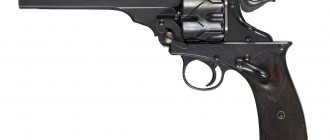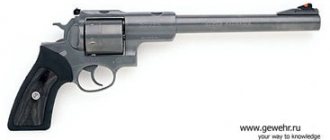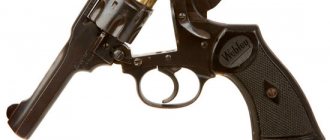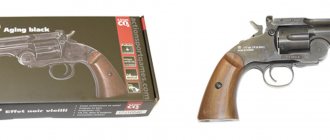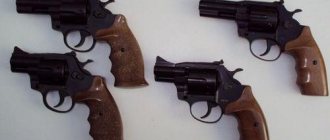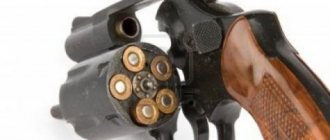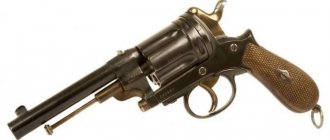By the beginning of the First World War, the armies of all the warring states arrived with the small arms that would later be used in both world wars practically unchanged. By 1914, the countries that would become participants in the war were armed with all types of weapons that are still in use today: drum revolvers, semi-automatic pistols, repeating rifles, and machine guns.
All these types of weapons had already been tested during the Boer War, as well as the Russo-Japanese War. The “oldest” of the small arms models were revolvers, which by that time had already been in service for more than half a century. The first revolver of a design close to the modern one is the Colt-Paterson mod. 1836. It had a capsule lock, and the chambers of the drum were charged one by one, first with a powder charge, and then separately with bullets. By 1913, revolvers were everywhere in service, using powerful and easy-to-handle unitary cartridges.
Revolvers "Webley" (Great Britain)
The still existing British company from Birmingham was one of the largest contractors for the British War Department during the First World War.
Revolver "Webley" Mk. VI
In 1867, the first Royal Irish Constabulary revolver was released, which was a huge commercial success and remained in production for over 50 years. There were a significant number of modifications of this weapon, differing in caliber and barrel length, although they all had an identical solid frame design and were extremely reliable in operation. These weapons were adopted by the Irish police (in 1886) and the London police, and were subsequently exported to Australia and other British colonies.
Since 1878, another popular army weapon was produced - the Army Express model. Designed for military use, these powerful .455 or .476 caliber revolvers were a significant improvement in design over all previous Webley models. A number of these revolvers were sold to South Africa and subsequently appeared in the troops of the South African Republic during the Boer War.
Another very successful revolver of this No. 2 "Bulldog". This compact revolver with a short barrel and, as a rule, a large caliber (.442, .450 and more) was extremely popular in the civilian and police weapons market. In addition, it was eagerly purchased by naval and army officers of the USA, Great Britain, Belgium, Spain and Ireland. The first Bulldog was released in 1872, until the mid-1950s. various companies have launched the production of its numerous copies (licensed and illegal) and imitations.
In particular, they were produced in the USA by Iver Johnson and Harrington & Richardson, in Belgium by Clement, Lepage, in Spain by Llama-Gabilondo, etc. In the early 1880s. one of the revolvers was put into service with the British Army instead of the Colt Navy revolvers mod. 1851 American made. It was designated "Webley" Mk. I. Until 1915, this revolver was modified 5 times, modifications from Mk. I to Mk. VIs were used in a number of wars and local conflicts, including World Wars I and II, the Korean War, and a series of British colonial conflicts.
Webley revolvers of various modifications were supplied to Russia before and during the First World War. Officially, revolvers produced by Philip Vebley were not in service, but they were purchased by officers of the Russian Imperial Army, as well as gendarmes, police officers and citizens of the aristocracy at their own expense.
It is a known fact that on the night of December 16-17, 1916, the “evil genius of Russian history” Grigory Rasputin was finished off with a control shot in the head from a Webley revolver. This made it possible to claim that Rasputin was killed by the British; the name of British intelligence agent MI6 Oswald Rayner was even named. However, the participation of the British in the direct murder of Rasputin is questioned by historians.
Links[edit]
- Dowell, William Chipchase, The Webley History
, Commonwealth Heritage Trust, Kirkland, WA, 1987. ISBN 0-939683-04-0. - HM Stationer's Office, List of Changes in British Military Equipment
, HMSO, London, Periodical. - Labyrinth, Robert J., Howdah to High Power: A Century of Breechloading Service Pistols (1867–1967)
, Excalibur Publications, Tucson, AZ, 2002. ISBN 1-880677-17-2. - Skennerton, Ian D., Small Arms Identification Series No. 9: .455 Pistol, No. 1 Mk VI Revolver
, Arms & Militaria Press, Gold Coast, QLD (Australia), 1997. ISBN 0-949749-30-3. - Smith, W.H.B., 1943. The Basic Guide to Military Small Arms
(facsimile), Stackpole Books, Harrisburg, PA, 1979. ISBN 0-8117-1699-6. - Markey, Mark and Skennerton, Ian D., .380 Enfield Revolver No.
2 , Greenhill Books, London, 1993. ISBN 1-85367-139-8. - Wilson, Royce, "A Tale of Two Collectibles", Australian Shooter
, March 2006. - Gerard Henrotin, "Webley Service Revolvers",
HLebooks.com Downloadable
eBook
, 2007 .
Revolver "Webley police & Military" MK. IV (UK)
Until the outbreak of World War II, it was one of the largest suppliers of weapons to the army of Great Britain and the Commonwealth countries. In the early 1880s. The command of the British Armed Forces announced a competition to replace Colt Navy revolvers mod. 1851 Along with the Enfield and Smith & Wesson revolvers, the Webley revolver also took part in the competition and won. It was officially accepted into service on July 18, 1887.
Revolver "Webley Police & Military" Mk. IV
The first sample was designated "Webley" Mk. I. Later the model was modernized five times. The last sample, designated Mk. The VI was officially declared the standard issue weapon on May 24, 1915. All of these brands were chambered in the larger .442, .455, or .476 calibers, although by 1899 the .455 cartridge had become the standard military ammunition and all other calibers were considered obsolete.
"Webley" - six-shot revolvers with a breaking frame, which had a handle characteristic of "Webley & Scott" in the shape of a "bird's head". Their improved, reliable firing mechanism consisted of only five parts. abandoned the traditional use of wood and began to equip its weapons with cheeks made of black ebony. Another innovation was the use of a special frame shield, which prevents the gradual expansion of the hammer striker hole during operation.
In the early 1920s. The British army adopted a new Enfield revolver of a smaller 38 caliber, so in the late 1920s. introduced an updated revolver model Mk. IV, chambered for 38-caliber cartridges. In the absence of government orders, the revolver was actively sold on the commercial market. It soon became popular with the police and was designated the "Police & Military" Mk. IV. These revolvers were supplied with barrels of different lengths.
In 1940-1945. The British War Office ordered the company about 100,000 Mk revolvers. IV. Finally, on December 20, 1945, this revolver, which had long been used in the army, was declared a standard weapon and remained so until 1956.
Notes[edit]
- "Historic Firearm of the Month", July 1999, Cruffler.com. Retrieved December 2, 2006.
- Ficken, Homer R. "Webley's 'The British Bull Dog' Revolver: Serial Numbering and Variations". Archived from the original on 2012-02-23. Retrieved March 28, 2011.
- Kinard, Jeff (2004). Pistols: An Illustrated History of Their Impact. ABC-CLIO. item 141. ISBN. 978-1-85109-470-7.
- § 6075, List of Changes in British Military Equipment
(hereinafter referred to as "LoC"), HM Stationer's Office, periodical - Skennerton, Ian D., Small Arms Identification Series No. 9: .455 Pistol, Revolver No. 1 Mk VI
, p. 6, Arms & Militaria Press, 1997. - Maze, Robert J., Howdah High Power
, p. 44, Excalibur Publications, 2002. - Dowell, William Chipchase, The History of Webley
, p. 115. Commonwealth Heritage Trust, 1987. - Dowell, William Chipchase, The History of Webley
, p. 114, Commonwealth Heritage Trust, 1987. - Dowell, William Chipchase, The History of Webley
, p. 115, Commonwealth Heritage Trust, 1987. - Dowell, William Chipchase, The History of Webley
, p. 116, Commonwealth Heritage Trust, 1987. - "Webley 1890" (PDF). Archived from the original (PDF) on February 15, 2011. Retrieved August 19, 2011.
- https://www.utting.org/writing/nvtu/shooting/prideaux-loader.pdf
- Dowell, William Chipchase, The History of Webley
, p. 178, Commonwealth Heritage Trust, 1987. - Maze, Robert J., Howdah High Power
, p. 49, Excalibur Publications, 2002. - Smith, W.H.B., 1943 The Basic Manual of Military Small Arms
(facsimile), p. 11, Stackpole Books, 1979. - Mark, Mark & Skennerton, Ian D., .380 Enfield Revolver No. 2
, p. 87, Greenhill Books, 1993. - Mark, Mark & Skennerton, Ian D., .380 Enfield Revolver No. 2
, p. 117, Greenhill Books, 1993. - Mark, Mark & Skennerton, Ian D., .380 Enfield Revolver No. 2
, p. 119, Greenhill Books, 1993. - "SA .380″ Ball Revolver Cartridge". Indian Ordnance Factories. Retrieved 2006-08-03.
- "Revolver 32 (7.65mm x 23)". Indian Ordnance Factories. Retrieved August 3, 2006.
- § 7816, LoC [ full citation required
] - § 9039 LoC
- § 9787 LoC
- § 16783 LoC
- § 17319 LoC
- Skennerton, Ian D., Small Arms Identification Series No. 9: .455 Pistol, Revolver No. 1 Mk VI
, p. 10, Arms & Militaria Press, 1997. - Mark, Mark & Skennerton, Ian D., .380 Enfield Revolver No. 2
, p. 9, Greenhill Books, 1993;
Smith, W.H.B., 1943 The Basic Manual of Military Small Arms
(facsimile), p. 11, Stackpole Books, 1979. - Maze, Robert J., Howdah High Power
, p. 103, Excalibur Publications, 2002. - § A6862, LoC
- § B2289, LoC
- § B6712, LoC
- Mark, Mark & Skennerton, Ian D., .380 Enfield Revolver No. 2
, p. 12, Greenhill Books, 1993. - Maze, Robert J., Howdah High Power
, p. 30, Excalibur Publications, 2002. - ↑
Robert Elman, Burnt in Anger, 1968 - Doerner, John A. "Lieutenant Colonel George Armstrong Custer at the Battle of the Little Bighorn". Martin Pate. Archived from the original on 2003-09-24. Retrieved August 3, 2006.
- Gallear, Mark (2001). "Guns at the Little Bighorn". Custer Association of Great Britain. Archived from the original on 2006-09-08. Retrieved August 3, 2006.
- Ficken, Homer R. "Webley's The British Bull Dog Revolver, Serial Numbering and Variations". Archived from the original on 2012-02-23. Retrieved April 2, 2011.
- Kekkonen, P. T. "Revolver British Bulldog". Gunsmiths. Retrieved August 3, 2006.
- Dowell, William Chipchase, The History of Webley
, p. 128, Commonwealth Heritage Trust, 1987. - Maze, Robert J., Howdah High Power
, p. 78, Excalibur Publications, 2002. - "Webley top-break revolvers". world.guns.ru. Archived from the original on 2016-11-30.
- ↑
Bishop, Chris (1998).
Weapons in battle
. Chartwell Books, Inc. ISBN 0-7858-0844-2. - "Weapons of the police and auxiliary forces in Malaya".
- Maung Aung Myoe (2009). Building the Tatmadaw: Myanmar's Armed Forces since 1948. ISBN 978-981-230-848-1.
- PPK Walter. Rhodesia's Hangover: An African Dilemma
. paragraph 49. - "World Infantry Weapons: Sierra Leone". 2013. Archived from the original on November 24, 2016.
- "Google Sites". sites.google.com
.
Revolver "Webley" MK. VI (UK)
Revolver "Webley" Mk. VI - the latest and most successful development - was first introduced in 1915. This revolver is a kind of quintessence of all previous models. The differences were minor and concerned mainly the shape of the handle (trapezoidal shape instead of the characteristic “bird’s head” of previous versions).
Revolver "Webley" Mk. VI
"Webley" Mk. VI in .455 caliber is a six-shot, break-action revolver. equipped her weapons with cheeks made of black ebony. This revolver had several very unusual design solutions. For example, it could be equipped with a bayonet mounted on the barrel, which would not interfere with shooting and was intended for trench fighting in the First World War. An attached stock was also developed for this weapon. However, such “exotic” did not gain much popularity.
The revolver was considered a durable and reliable weapon that did not require special care and had a powerful stopping effect. However, it was very difficult for an untrained beginner to shoot such a powerful weapon.
"Webley" Mk. VI became the main sidearm in the British army until the end of the First World War. In 1921, production was transferred to the “sworn friend” - a state-owned enterprise in Enfield. This model remained the standard weapon until 1932. It is also known as the Enfield No. 1Mk. VI.
Users[edit]
| This section requires additional links for verification . |
- British Empire [42]
- Canada
- Hong Kong: retired
- India
- Ireland
- Israel
- Luxembourg
- Malaysia [43]
- Myanmar: retired [44]
- Philippines
- Pakistan
- Rhodesia [45]
- Sierra Leone [46]
- Singapore: Retired
- Switzerland
- Tunisia: retired
- Tanzania [47]
Revolver "Enfield" No. 2 MK. I (UK)
The Royal Small Anns Factory (RSAF) of Enfield Lock, Middlesex, was ordered by the government in July 1879 to produce revolvers to replace the Colt Navy M 1851 revolvers.
Revolver "Enfield" No. 2 Mk. I
The design of the new weapon for powerful .476 caliber ammunition was developed and approved within 16 days. On August 11, 1880, the Enfield Mk. revolver. I was officially adopted into service. However, it had some design features that did not meet safety requirements. A new revised model was introduced in September 1880 and received the official Mk designation in March 1882. P.
However, according to the military, the Enfield revolvers did not live up to expectations, and they were soon abandoned in favor of the Webley revolvers described earlier. From this time on, Enfield no longer designed military revolvers, but was only engaged in refining Webley revolvers.
After World War I, the British Army abandoned high-powered ammunition in favor of .38 (9 mm) cartridges, and in the mid-1920s. a 38-caliber revolver with the index “Enfield” No. 2 Mk was presented. I It was not an independent development of Enfield, but appeared thanks to Webley designers with the assistance of RSAF engineers. The official approval of this model took place in June 1932.
Enfield No. 2 Mk. I—six-shot double-action revolver. The drum is discharged by breaking the frame. In this case, the cartridges fall out on their own, and the weapon can be quickly reloaded.
The revolver turned out to be quite reliable. The chambers have a tapered shape in case the bullet is not seated tightly in the cartridge case. A special stopper prevents accidental rotation of the cylinder when worn in a holster. Another safety locks the trigger when the cylinder is open. The design of the first models included an automatic trigger safety when the weapon was not cocked; in 1942, in order to facilitate production, it was abandoned. In June 1938, a “tank” modification appeared, which lacked the trigger shank, which interfered with the crews inside the combat vehicle compartments.
Significant shortcomings of the revolver were the insufficient stopping effect of the bullet compared to the 455 caliber and the high resistance of the trigger, which interfered with accurate shooting.
Revolver "Enfield" No. 2 Mk. I was produced in large quantities during the Second World War. In addition to RSAF, these revolvers were produced by Albion Motors Ltd. from Glasgow, and the famous sewing machine manufacturer Singer supplied components. The total production volume was no less than 380,000 units. The weapons were not officially exported; all revolvers entered service with the armies of Great Britain and the metropolises. In the mid-1950s. all types of Enfield and Webley revolvers were replaced by Belgian Browning Hi Power pistols mod. 1935
History
Webley & Scott (P. Webley & Son before merger with W & C Scott in 1897) produced a range of revolvers from the mid 19th to late 20th centuries. As early as 1853 P. Webley and J. Webley began production of their first patented single action cap and ball revolvers. Later under the trade name of P. Webley and Son, manufacturing included their own 0.44 in (11 mm) caliber rim-fire solid frame revolver as well as licensed copies of Smith & Wesson's Tip up break action revolvers. The quintessential hinged frame, centre-fire revolvers for which the Webley name is best known first began production/development in the early 1870s most notably with the Webley-Pryse (1877) and Webley-Kaufman (1881) models. The WG or Webley-Government models produced from 1885 through to the early 1900s, (often incorrectly referred to as the Webley-Green) are the most popular of the commercial top break revolvers and many were the private purchase choice of British military officers and target shooters in the period, coming in a .476/.455 caliber. However other short-barrel solid-frame revolvers, including the Webley RIC (Royal Irish Constabulary) model and the British Bulldog revolver, designed to be carried in a coat pocket for self-defense were far more commonplace during the period. Today, the best-known are the range of military revolvers, which were in service use across two World Wars and numerous colonial conflicts.
In 1887, the British Army was searching for a revolver to replace the largely unsatisfactory .476 Enfield Mk I & Mk II revolvers, the Enfield having only replaced the solid frame Adams .450 revolver which was a late 1860s conversion of the cap and ball Beaumont –Adams revolver in 1880. Webley & Scott, who were already very well known makers of quality guns and had sold many pistols on a commercial basis to military officers and civilians alike, tendered the .455 caliber Webley Self-Extracting Revolver for trials. The military was suitably impressed with the revolver (it was seen as a vast improvement over the Enfield revolvers then in service, as the American-designed Owen extraction system did not prove particularly satisfactory), and it was adopted on November 8, 1887 as the “ Pistol, Webley, Mk I.” The initial contract called for 10,000 Webley revolvers, at a price of £3/1/1 each, with at least 2,000 revolvers to be supplied within eight months.
The Webley revolver went through a number of changes, culminating in the Mk VI, which was in production between 1915 and 1923. The large .455 Webley revolvers were retired in 1947, although the Webley Mk IV .38/200 remained in service until 1970 alongside the Enfield No. 2 Mk I revolver. Commercial versions of all Webley service revolvers were also sold on the civilian market, along with a number of similar designs (such as the Webley-Government and Webley-Wilkinson
) that were not officially adopted for service, but were nonetheless purchased privately by military officers. Webley's records show the last Mk VI was sold from the factory in 1957, with “Nigeria” noted against the entry.
Nagan system revolver arr. 1895 (Russia, USSR)
In 1887, Belgian designers, brothers Emil and Leon Nagan, developed a revolver of a special design. When cocking the hammer, the drum moved onto the barrel breech so that when fired, the gap between the drum and the barrel was tightly closed. This design made it possible to almost completely eliminate the breakthrough of powder gases during shooting. To reduce the forward movement of the drum, the bullet was closed with a sleeve.
Nagan system revolver arr. 1895
Nagant revolvers were brought to Russia in 1891 to replace the 10.4 mm Smith & Wesson revolvers of the “Russian” model. The Nagant revolver was tested along with the revolvers of the Belgian X. Pieper, the six-barreled Mosin pistol and the automatic pistol of the German Bergman. The accuracy of the revolver's combat turned out to be higher than that of other models. In 1895, the Nagant revolver chambered for the 7.62 mm “three-line” cartridge was adopted by the Russian army.
Experts noted that the Nagant revolver achieved a successful combination of sufficient accuracy, low weight and acceptable dimensions with simplicity of design and reliability. The drum held not 6 (as usual), but 7 rounds. However, the main disadvantage of the revolver was the non-folding drum with a very long reload. Cartridges were inserted and extracted only individually.
The first batch of Nagan revolvers mod. 1895 was manufactured for Russia by a Belgian supplier at factories in Liege. In 1898, their production was established at the Tula Arms Plant. Nagant revolvers were manufactured in two versions. Some categories of privates and non-commissioned officers were armed with a “soldier’s” single-action revolver (the hammer was manually cocked for each shot). The “officer” model, self-cocking, made it possible to fire without first cocking the hammer.
The “soldier’s” revolver was made by adding an extra part to a self-cocking revolver, which prevented self-cocking shooting. This was nothing more than an artificial reduction in the combat qualities of the “revolver”, and was done to please the opinion that it was irrational to give the lower ranks weapons that were “too” fast-firing.
By 1917, the Tula Arms Plant produced about 500,000 Nagan system revolvers. The revolver successfully went through the Russian-Japanese and First World Wars, and after the October Revolution it was adopted by the command staff of the Red Army. Since 1921, Nagant revolvers in Soviet Russia have been produced in only one type - “officer” revolvers.
The high reliability of the revolver for a long time did not allow it to compete with it. Only in 1931 they tried to replace it with a Tokarev pistol. In 1935, only 12,000 revolvers were produced, in 1937 - 72,000, in 1938 - 98,000. Nagant revolvers continued to be produced in the USSR until 1943 (in 1941, 118,000 of them were already produced, and in 1942 - only 15,000 pieces). In the Red Army, their complete replacement with automatic pistols occurred only after 1945. The total volume of revolvers produced in Russia and the USSR exceeds 1.5 million units.
Revolvers "Smith & Wesson" (Russian Model) arr. 1871-1880 (Russia, USA)
Revolver "Smith & Wesson Russian"
In the battles of the First World War, the Russian Army used a significant number of revolvers of the Smith & Wesson system, which were in service with officers and soldiers of some special units until 1895, when the new standard revolver of the Nagant system began to be supplied to the troops.
The Russian military department paid attention to revolvers of the Smith & Wesson system in the late 1860s. The advantage of a revolver of this system was the presence of a turning frame and a mechanism for simultaneous ejection of spent cartridges, which greatly facilitated the reloading process.
A modified “American” .44 caliber model was chosen for adoption by the Russian Army.
The first contract for the supply of 20,000 revolvers was concluded in May 1871. Then, at the request of the Russian military, the revolver was modernized. It began to be equipped with a heel - a special protrusion at the end of the handle, which did not allow the handle to move under the influence of recoil. The safety bracket now has an additional support for the middle finger. The barrel length of the improved, or "cavalry", model was reduced from 203 to 165 mm.
But the main change occurred not with the revolver, but with the cartridge for it. The bullet diameter of the original .44 Smith & Wesson cartridge was slightly smaller than the bore diameter. Russian engineers increased the bullet diameter, the muzzle velocity increased from 195 to 225 m/s. When ordering “Russian” revolvers from Smith & Wesson, the need to drill out the cylinder chambers was specifically stipulated. The total number of Smith & Wesson revolvers delivered to Russia exceeded 130,000. This number included 20,000 revolvers of the first model, 70,000 revolvers of the second and more than 41,000 revolvers of the third, “cavalry” model.
Memory of a tank
Much more Mk V tanks have survived than its predecessors. Including several of these tanks can be seen here in Russia.
- A captured British Mark V tank in Arkhangelsk, which the Red Army captured here in 1920. Also in Arkhangelsk, 13 more tanks were captured and transferred to other Russian cities. For example, Mark V “hermaphrodite” can be seen in Kharkov;
- Another “hermaphrodite” was installed in Lugansk;
- Mk V with a rather interesting coloring is on display at the Central Museum of Armored Weapons and Equipment in Kubinka;
- The Mk V is on display at London's Imperial War Museum.
Revolver "Smith & Wesson" M 1905 (USA)
Produced from 1899 to the present day, the “Military and Police” revolver is considered the most successful weapon in its class. It all started with the development of our own .38 caliber cartridge based on the .44 caliber cartridge used in the “Russian” series revolvers. The weapon, created for the new .38 SW cartridge, had greater accuracy than that of Colt revolvers, due to the specially shaped bullet.
Revolver "Smith & Wesson" M 1905
In terms of the design of the weapon itself, Smith & Wesson engineers did not come up with anything revolutionary. The company's previous developments were taken as a basis. This revolver had a monolithic frame and a drum that folded to the left after the lock was released. Only metal processing technology has changed slightly.
Smith & Wesson .38 caliber revolvers soon became extremely popular. On the eve of World War II, the US Navy was armed with M1905 Military and Police model revolvers. This was the eighth improved model of the “Military and Police” M 1899 revolver, which had been in service with the US police, army and navy since 1900.
From March 11, 1940 to March 9, 1945, 568,204 such revolvers were produced, almost all of which were delivered to the UK, where they even managed to displace the very popular Enfield revolver.
The number of M 1905 and British model revolvers produced is impressive. The first million were produced before April 24, 1942, and by March 1948, 2 million copies were produced. During the war years, revolvers that appeared after the release of the millionth copy received the letter V and the name “Victory” in front of the series number. They had no differences from the base model. In December 1944, the letter designation VS appeared. The letter S meant that the weapon had better protection against accidental shooting.
The Smith & Wesson M 1905 revolvers were reliable weapons with good ballistic characteristics and earned the well-deserved respect of military personnel in the US and British armies.
Revolver "Colt Army Special" M 1908 (France)
One of the most popular models of army revolvers was the “Colt Army Special” M1908 revolver (rather, a whole line of revolvers, going through army procurement documents under one index).
Revolver "Colt Army Special" M 1908
“Colt” M1908 is a “descendant” of the famous “Colt Navy” M 1889 and “Colt Army & Navy” M 1892 revolvers.
The revolver has a one-piece frame and a double-action trigger mechanism. The reloading drum is tilted to the side.
The Colt Army Special M 1908 revolver was produced with different barrel lengths. There were modifications chambered for .32 “Winchester”, .38 “Smith & Wesson”, as well as .38 “Special” and .455 LA. The M 1908 revolver officially entered service with the US Navy, and then with linear infantry units, so that every infantry or naval officer, a member of a machine gun team or a crew member of an armored vehicle or tank could choose a revolver depending on his preferences. During the First and Second World Wars, modifications of Colt Army Special revolvers were actively exported, primarily to Great Britain.
According to some information, until 1943, about 400,000 revolvers of this brand were produced in various calibers and with different barrel lengths. In total, from 1908 to the 1970s. More than 700,000 Colt M 1908 units were produced.
Modifications
In total, two main modifications of the Mk-V were produced:
- Mark V* - Tadpole Tail. It was lengthened to overcome 3.5 meter German trenches on the Hindenburg Line. A total of 645 Mark V* were produced. It weighed 33 tons “male” and 32 tons “female”. Also on this version, a compartment for transporting infantry was installed, however, due to poor ventilation, the soldiers were incapacitated after transportation, so it was decided to transport cargo and equipment in it;
- Mark V**. This version of the Mark-V with a more powerful engine of 225 hp. appeared in 1918. A total of 197 examples were built.
When in April 1918 the battle with German tanks near Villers-Brenton showed the complete incapacity of the “females”, instead of one machine gun it was decided to install a cannon on them. This modification became conventionally called “hermaphrodite”, and most of the already released Mk-V females were converted into it.
